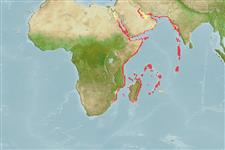>
Eupercaria/misc (Various families in series Eupercaria) >
Labridae (Wrasses) > Corinae
Etymology: Macropharyngodon: Greek, makros = great + Greek, pharyngx = pharynx + Greek,odous = teeth (Ref. 45335).
More on author: Smith.
Environment: milieu / climate zone / depth range / distribution range
Écologie
marin récifal; non migrateur; profondeur ? - 30 m. Subtropical
Western Indian Ocean: from Zanzibar to Mozambique and Aldabra, Sychelles, Réunion, Mauritius and Maldives, South Africa (Kwa-Zulu-Natal), Chagos Archipelago, southern Oman, Rodrigues, and Yemen.
Taille / Poids / Âge
Maturity: Lm ? range ? - ? cm
Max length : 13.0 cm TL mâle / non sexé; (Ref. 30573)
Description synthétique
Clés d'identification | Morphologie | Morphométrie
Épines dorsales (Total) : 9; Rayons mous dorsaux (Total) : 11; Épines anales: 3; Rayons mous anaux: 11.
Inhabits lagoon and sheltered seaward reefs (Ref. 9710). Occurs singly or in pairs; females often found in small groups (Ref. 9710). Feeds on invertebrates by picking items from the substratum. Burrows in the sand at the sign of danger (Ref. 5503).
Life cycle and mating behavior
Maturité | Reproduction | Frai | Œufs | Fécondité | Larves
Oviparous, distinct pairing during breeding (Ref. 205).
Randall, J.E., 1978. A revision of the Indo-Pacific labrid fish genus Macropharyngodon, with descriptions of five new species. Bull. Mar. Sci. 28(4):742-770. (Ref. 2694)
Statut dans la liste rouge de l'IUCN (Ref. 130435: Version 2024-1)
Menace pour l'homme
Harmless
Utilisations par l'homme
Pêcheries: sans intérêt; Aquarium: Commercial
Outils
Articles particuliers
Télécharger en XML
Sources Internet
Estimates based on models
Preferred temperature (Ref.
123201): 24.9 - 29.1, mean 27.5 °C (based on 716 cells).
Phylogenetic diversity index (Ref.
82804): PD
50 = 0.5002 [Uniqueness, from 0.5 = low to 2.0 = high].
Bayesian length-weight: a=0.00977 (0.00466 - 0.02049), b=3.07 (2.90 - 3.24), in cm total length, based on LWR estimates for this (Sub)family-body shape (Ref.
93245).
Niveau trophique (Ref.
69278): 3.5 ±0.37 se; based on food items.
Résilience (Ref.
120179): Haut, temps minimum de doublement de population inférieur à 15 mois (Preliminary K or Fecundity.).
Fishing Vulnerability (Ref.
59153): Low vulnerability (10 of 100).
Nutrients (Ref.
124155): Calcium = 61.2 [28.2, 137.5] mg/100g; Iron = 0.763 [0.403, 1.577] mg/100g; Protein = 19.2 [16.3, 21.4] %; Omega3 = 0.247 [0.135, 0.449] g/100g; Selenium = 10.6 [4.9, 22.7] μg/100g; VitaminA = 91.9 [25.8, 418.7] μg/100g; Zinc = 1.19 [0.72, 2.07] mg/100g (wet weight);
